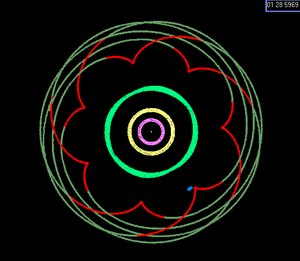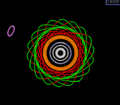Orbital resonance facts for kids
Orbital resonance is when two orbiting bodies exert a regular, periodic gravitational effect on each other. Their orbital periods may be related by a ratio of two small integers. It is caused by the changing gravitational forces of bodies which go round each other. The stability of the Solar System was first investigated by Laplace, and there is still much that is not known about it.
As a satellite goes round a planet or two stars go round each other, the gravitaional forces can change, sometimes hugely. This is partly because orbits are usually ellipses, not circular, and so the forces change accordingly. Also, the planets and stars are usually not spherical. They spin, and vary in their degree of oblateness. This also changes the forces on an orbiting body.
In particular, the forces may be unstable, so the smaller partner may change until the forces are stable (do not change with time). Satellites often end up with one face towards their planet, because that is the most stable position (tidal locking). There are other stability effects. Gaps in Saturn's rings are caused by the particles shifting into more stable positions. In the rings of Saturn, the Cassini Division is a gap between the inner B Ring and the outer A Ring. It was cleared by a 2:1 resonance with the moon Mimas. There is a stability ratio for Neptune and Pluto: the 2:3 ratio means Pluto completes two orbits in the time it takes Neptune to complete three.
The area of mechanics which is used for these studies is called celestial mechanics.
Images for kids
-
The three-body Laplace resonance exhibited by three of Jupiter's Galilean moons. Conjunctions are highlighted by brief color changes. There are two Io-Europa conjunctions (green) and three Io-Ganymede conjunctions (grey) for each Europa-Ganymede conjunction (magenta). This diagram is not to scale.
-
Spiral density waves in Saturn's A Ring excited by resonances with inner moons. Such waves propagate away from the planet (towards upper left). The large set of waves just below center is due to the 6:5 resonance with Janus.
-
The eccentric Titan Ringlet in the Columbo Gap of Saturn's C Ring (center) and the inclined orbits of resonant particles in the bending wave just inside it have apsidal and nodal precessions, respectively, commensurate with Titan's mean motion.
-
Depiction of asteroid Pallas' 18:7 near resonance with Jupiter in a rotating frame (click for animation). Jupiter (pink loop at upper left) is held nearly stationary. The shift in Pallas' orbital alignment relative to Jupiter increases steadily over time; it never reverses course (i.e., there is no libration).
-
Depiction of the Earth:Venus 8:13 near resonance. With Earth held stationary at the center of a nonrotating frame, the successive inferior conjunctions of Venus over eight Earth years trace a pentagrammic pattern (reflecting the difference between the numbers in the ratio).
-
Diagram of the orbits of Pluto's small outer four moons, which follow a 3:4:5:6 sequence of near resonances relative to the period of its large inner satellite Charon. The moons Styx, Nix and Hydra are also involved in a true 3-body resonance.
See also
 In Spanish: Resonancia orbital para niños
In Spanish: Resonancia orbital para niños










